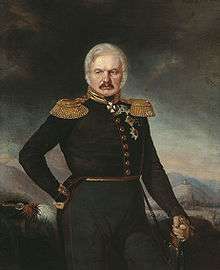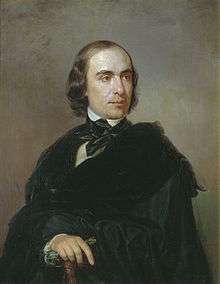Pyotr Zakharov-Chechenets
Pyotr Zakharovich Zakharov-Chechenets (Russian: Пётр Захарович Захаров-Чеченец; 1816–1846) was a Russian painter of Chechen origin. He is believed to be the only professional painter of Chechen origin in the 19th century.[1][2]
.jpg)
In 1819, during the Caucasian War Russian troops found a dead woman and a dying wounded three-year-old baby in the Chechen aul Dady-Yurt. The commander-in-chief of the Russian army Aleksey Petrovich Yermolov ordered military medics to do everything possible to save this baby despite all medical advice saying that it was impossible. Against all the odds the baby survived.[3] The baby was given for nursing to Cossack Zakhar Nedonosov. From the name of this Cossack the baby got his surname and patronymic.[4] Later Pyotr appended the word Chechenets to his surname in order to show his ethnic identity.
At the age of seven Pyotr was adopted by Major-General Pyotr Yermolov, Commanger of Georgian Grenadier regiment and a cousin of Aleksey Petrovich Yermolov.[3] Despite having seven children of his own, Pyotr Yermolov liked Zakharov very much and treated him as his own son.[2]
The boy showed talent in painting and Pyotr Yermolov tried to send him to the Imperial Academy of Arts in Saint Petersburg but he was rejected. The president of the Academy, Aleksey Olenin, claimed that the 10-year-old boy was too young to study at the Academy and recommended hiring a private teacher. The boy got his lessons from the portraitist Lev Volkov.
At the age of 17, he eventually entered the Academy and graduated in 1835 with a diploma of Free Artist. During his study at the Academy he got positive acclaims for his works and was recommended for a scholarship to study art in Italy. The trip might have been helpful both for Zakharov's artistic growth and for his health as he started to show signs of tuberculosis.
Nevertheless, Zakharov's name was withdrawn from the list for the scholarship by Emperor Nicholas I of Russia himself as he insisted that national minorities (inorodtsy) should not benefit from the Academy's scholarships.[4] Another misfortune was soon to follow as Zakarov's first teacher, Lev Volkov, refused to allow his daughter to marry Zakharov despite the young people being madly in love. Instead Volkov had her sent to relatives in the Caucasus with an order to marry her off to any first-comer just to stop the affair.[4]
Zakharov worked a lot and soon became a fashionable portraitist. His clients even included the favorite daughter of Nicholas I, Grand Duchess Maria Nikolayevna and her future husband Maximilian, Duke of Leuchtenberg.[3] In 1837, he was admitted to the state service as an Artist at the Military Department.[3] In 1842, the Portrait of Aleksey Petrovich Yermolov caused him to become a member of the Academy of Arts.[5]
On 14 January 1846, Zakharov married his beloved bride but their happiness was short. On June 13 his wife died from tuberculosis and a few months later Zakharov died from the same disease.[3]
Many works of Zakharov-Chechenets are kept in the Tretyakov Gallery and in the Russian Museum. The Art Museum in the capital of Chechnya, Grozny also used to have many of his works including his Selfportrait, and Portrait of I.F. Ladygensky. In 1995 during the First Chechen War the Grozny Museum was heavily damaged and the paintings were all but destroyed. Since 1995, they are being restored at the Grabar Restoration Center in Moscow.[1]
Works
.jpg) Self-portrait as a young man
Self-portrait as a young man Portrait of Aleksey Petrovich Yermolov, 1842
Portrait of Aleksey Petrovich Yermolov, 1842 Children of Pyotr Yermolov, 1839
Children of Pyotr Yermolov, 1839 Portrait of historian Timofey Granovsky, 1845
Portrait of historian Timofey Granovsky, 1845
See also
| Wikimedia Commons has media related to Zakharov-Chechents. |
References
- 1 2 Grozny Art Museum (Russian)
- 1 2 Biography of famous Chechens (Russian)
- 1 2 3 4 5 Article P.Zakharov on the Russian History in the mirror of visual arts site (Russian)
- 1 2 3 Zakharov-Chechenets article on the Chechen Cultural Figures site
- ↑ Pyotr Zakharov in the Brockhaus and Efron Encyclopedic Dictionary (Russian)